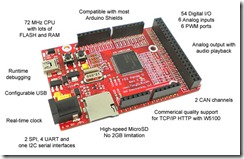New Kits from GHI Electronics
In case you haven’t been out to the GHI site in the last few days, they just announced a new set of kits (https://www.ghielectronics.com/catalog/category/38/). These kits are intended to give you an easy on-ramp to building things. I have found that people who want to build small devices are stopped by two things – what to build and where do I learn enough electronics to be successful. These kits aim at reducing these barriers for folks new to the world of small devices by lowering the complexity of connecting up peripheral components greatly simplifying the required electronics knowledge required. The .NET Micro Framework and Visual Studio give you a great place to start programming. The other part of the story, the example projects of what you can build with these kits, is addressed on the forums for the first two kits and in an online book for the second two kits. On the forums, you can find a number of projects and get assistance if needed from the authors of those projects.
The new on-line book (https://www.ghielectronics.com/downloads/FEZ/FEZ_Internet_of_Things_Book.pdf) is focused on the exciting area of connected devices and has a number of cool projects that leverage that connectivity. Once you get through these projects, you will have the tools needed for the next generation of connected devices.
The robot kit has been around for a while and for this kit the initial application is obvious – autonomous navigation. The kit comes with the sensors needed for a line following robot or wander around within a defined space. You can also swap in the InfraRed Distance sensor (available but not included) and ramble around the house scaring the family cat. You can see all the eblock peripherals available at https://www.ghielectronics.com/catalog/category/3/.
The next kit is the FEZ Education Kit with a number of pluggable modules including LEDs, a button, a piezo (for making noise), and a dial (variable resistor). The kinds of projects that you can do with these peripherals include lighting LEDs in response to button presses or changing the tone output by the piezo when you turn the dial or connect the device to you PC to interface with Matlab. You can then extend the project with additional peripherals like a thermometer that changes the LED that is lit based on the temperature detected.
These first two kits are built using the FEZ Mini. This means that once you are ready to try something not supported by the eblocks available, you are not stuck. All of the IO that you need to connect a variety of other peripherals that you can get at any hobbyist site. The IO supported requires that you solder in a header but that is not difficult if you read up on it and are careful. Alternatively, you can use the Mini on a breadboard but then you lose the eblocks. Either way, it means that you can run servos, get additional sensors, and many other extensions.
The next kit is the Internet of Things kit. There is an explosion of interest in connected devices and this is a great way to play around with this. This kit and the next one are based on the Arduino form factor. That means that you can use the FEZ Connect shield to support an Ethernet connection and eblocks and motors as well as selecting from a wide range of Arduino compatible shields that are available commercially. This kit does not include the processor board so you have to select one of the Arduino form factor boards available that start at about $35. With this kit, you could build a device that moves in response to commands from the remote control. You can also connect up to the internet and be a sensor node for the wider Internet of Things at a site like Pachube.com.
Finally, there is the FEZ Ultimate kit which starts with the Internet of Things kit and adds the processor that was not included in the IoT kit and a touch display. The processor that you get is the FEZ Panda II which includes an SD slot so that you can create files and store data. With this kit, you also have the opportunity to work on cool touch interfaces. You can make a UI for your applications that includes images and buttons and gestures just like your phone.
For people who are just starting out and not sure about what to build or how to connect peripherals, these kits are a great way to get started safely. The great part about it is that they are not limited to the things that you can build out of the box. As you get more comfortable, you can start exploring the full range of things that you can do with a small processor which is pretty much limited to your imagination and examples that you can find online.
Technorati Tags: .NET Mciro Framework,NETMF,GHI ELectroincs,FEZ,Electronics,education,robotics
